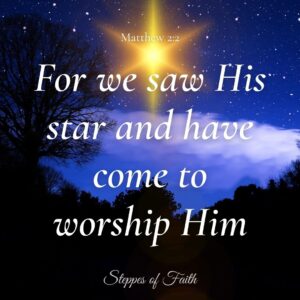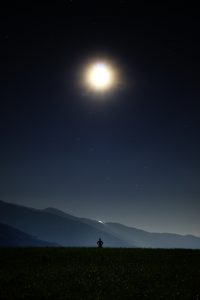
“For we saw His star when it rose and have come to worship Him.” Matthew 2:2
Some events in the Bible do not seem to make sense. Take the Christmas story, for example. It contains three peculiar occurrences: an unprecedented census, the sudden appearance of angels to a group of shepherds, and a bright star leading foreign Magi hundreds of miles to Bethlehem. How could these things have happened?
The Bible contains many mysteries, and we will never know the answers to some of them. But God has not hidden the lessons of the Christmas story. It is far more than a simple tale of the Messiah’s birth.
Planting an Idea
The Christmas story and its first curious event occurs in Luke 2:1. During Mary’s pregnancy, the Roman emperor Caesar Augustus decreed a census of all the men in Israel.
Up to this time, Jews were not allowed to serve in the Roman army, but Caesar decided to change this rule. He established a series of surveys for governors to take every fourteen years, each being a headcount for military conscription (which only added to the Jews’ hate for the Romans). Never before had a ruler wanted to count every able-bodied man in his kingdom.
To complete the census, Caesar required every Jewish man from every tribe to return to his hometown and register. And so, being a member of King David’s lineage, Joseph and his very pregnant wife, Mary, journeyed to Bethlehem, ninety-six miles away, fulfilling an Old Testament prophecy.
“But you, Bethlehem Ephrathah, though you are little among the thousands of Judah, yet out of you shall come forth to Me the One to be Ruler in Israel whose goings forth are from of old, from everlasting.” (Micah 5:2)
God placed an unheard-of idea in Caesar’s head that required Joseph and Mary to travel by donkey to Bethlehem dozens of miles away. Without such a compulsion, Jesus would not have been born in Bethlehem but Nazareth.

A Celestial Conjunction
Another mystery of Christmas is the bright star that guided the Magi to Jesus. For decades, many astronomers have tried to explain how such a bright light could have possibly occurred. Some have suggested it was a meteor; others say it was a nova or supernova.
One possible idea is that Jupiter was in conjunction with Saturn by one degree in 7 B.C. Together, they passed through the sky three times that year, creating a “super conjunction,” according to astronomical charts. Such a display in the sky would have certainly gained the attention of the astrologist Magi.
Four years later, Jupiter was in conjunction with Venus within the constellation Leo in 3 B.C. Israelites considered Leo a sacred part of the sky whenever it appeared. Later, in the time of the early church culture, individual Christians correlated the constellation to Jesus as the Lion of Judah.
According to astronomers, the sun’s reflection created an overwhelming light when Jupiter, Venus, and Leo aligned in August 3 B.C. Such close conjunction would have appeared in the eastern dawn sky, making it very easy for the Magi “in the East (Matthew 2:2)” to see.
The Planets and Stars Align
During the day, Venus would disappear, but Jupiter and Leo continued to shine. And this, along with other incredible star conjunctions, continued for ten months. Theoretically, it gave the Magi plenty of time to travel to Jerusalem.
We do not know the exact date of Jesus’ birth, and many scholars believe it likely was not in December. However, historians have determined King Herod’s death to occur sometime between 4 and 1 B.C. Therefore, Jesus’ birth and the Magi’s discovery of Him must have occurred during this timeframe, likely in the late spring of 2 B.C.
According to star charts, Leo began to sink into the sky in June 2 B.C. But Jupiter and Venus continued to move closer together until they were within only 0.6 arc minutes of each other (for reference, the stars in Big Dipper’s handle are 12 arc minutes apart). The two planets appeared to be almost on top of each other. It might have looked like a bright beacon in the sky during the twilight evening hours.
Bible theorists speculate that Herod’s chief priests and scribes probably missed these incredible events because they always occurred in the pre-dawn hours when the priests and scribes were likely sleeping.

Other Curious Magi Questions
Following a star across hundreds of miles is one thing. But how could the Magi precisely follow a star only six miles from Jerusalem to Bethlehem?
The Bible does not tell us how the Magi found the exact place where Mary, Joseph, and Jesus were. Some theorize it may have been as simple as asking the neighbors, which the Bible indicates by using the present participle of “saying” in Matthew 2:2.
“Now after Jesus was born in Bethlehem of Judea in the days of Herod the king, behold, wise men from the East came to Jerusalem, saying, ‘Where is He who has been born King of the Jews? For we have seen His star in the East and have come to worship Him.'”
Such use of grammar in Matthew 2:2 could indicate the Magi went around town continuously asking everyone they encountered where Jesus was. But this is only speculation.
Science alone cannot fully explain what happened in the sky the year the Magi visited baby Jesus. Astronomer Hubert J. Bernhard at San Francisco’s Morrison Planetarium fully admitted this in a lecture in 1967.
“If you accept the story told in the Bible as the literal truth, then the Christmas Star could not have been a natural apparition. Its movement in the sky and its ability to stand above and mark a single building; these would indicate that it was not a normal phenomenon but a supernatural sign. One given from on high and one that science will never be able to explain.”
God created the heavens, and He alone controls them (Genesis 1:1). He counts the stars and knows them by name (Psalm 147:4), and He alone ordains what they do.
“It is I who made the earth and created man upon it. I stretched out the heavens with My hands, and I ordained all their host.” Isaiah 45:12
Shekinah Glory
Only God could have aligned the planets and stars so the Magi could find Jesus and worship Him. But the more likely explanation of the star is not an unusual alignment of planets but the Shekinah glory of God Himself.
Shekinah glory is the physical manifestation of God’s presence.
We see God’s Shekinah glory in Exodus 3 when He appeared as a burning bush to Moses. He also appeared as a pillar of clouds leading the Israelites through the wilderness during the day and as a pillar of fire during the night (Exodus 13:21). He appeared again as a cloud to Moses three more times.
“When Moses entered the tent, the pillar of cloud would come down and remain at the entrance to the tent.” (Exodus 33:9)
“Then the LORD descended in a pillar of cloud, stood at the entrance to the tent, and summoned Aaron and Miriam.” (Numbers 12:5)
“The LORD appeared at the tent in a pillar of cloud, and the cloud stood at the entrance to the tent.” (Deuteronomy 31:15)
God’s presence also appeared to Moses as fire in Exodus 19:18 and again as a cloud and fire in Exodus 40:38 and Deuteronomy 4:11-24, 33-36. But Shekinah glory was not limited to Moses. It also appeared to:
- Gideon in Judges 6:21; 13:20
- Elijah in 1 Kings 18:38
- King Solomon in 2 Chronicles 7:1-3
God’s Shekinah glory is also mentioned in the Psalms (18:8, 12-13; 50:3, 97:1-5) and by the prophets Isaiah (66:15-16) and Daniel (7:9).
God is still performing miraculous signs that lead us to Jesus so that we may worship the one true King. But in the case of the Magi, it likely was not an alignment of planets but the glorious presence of God leading them straight to Jesus, lying in a manger.
Did the Shepherds See a Star?
Most Christmas stories on television and in books depict certain shepherds finding Jesus in a barn somewhere in Bethlehem. But notice the account of the shepherds in Luke 2. There is no mention of any stars, only the Shekinah glory of the Lord shining around them.
“And behold, an angel of the Lord stood before them, and the glory of the Lord shone around them, and they were greatly afraid…So it was, when the angels had gone away from them into heaven, the shepherds said to one another, ‘Let us now go to Bethlehem and see this thing that has come to pass, which the Lord has made known to us.’ And they came with haste and found Mary and Joseph and the Babe lying in a manger.” Luke 2:9,15-16
These priest shepherds did not have a star to follow. They only knew they had to go to the City of David (Bethlehem), where, like the Magi, they likely asked the neighbors if they knew anyone who had given birth recently.
“Now when they had seen Him, they made widely known the saying which was told them concerning this Child.” Luke 2:17
[READ MORE: The Real Truth About the Shepherds on That First Christmas Night]

God’s Will for You
Whether it is the sudden idea of taking a census, a theoretical, supernatural conjunction of planets and stars, Shekinah glory, or a personal visit from heavenly angels, God indeed moved heaven and earth to ensure the fulfillment of prophecy.
Why would God go to so much trouble?
It was not just for the sake of prophecy alone. God does these things to compel us to find Jesus, surrender to His grace, and worship Him. And God will continue to do this until Jesus returns to claim His kingdom. Jesus Himself tells us this in John 4:23.
“But the hour is coming, and now is, when the true worshipers will worship the Father in spirit and truth; for the Father is seeking such to worship Him.”
God will do anything to draw you to His saving grace. He is seeking—not hoping and wishing, but actively seeking—us to worship Him. This is His will for us.
We may be unable to explain everything that happened in the days leading up to Jesus’ birth or many other mysteries in the Bible. Some parts will not make immediate sense to us on this side of heaven. But His will for us is always the same.
God still invites us to go and find Jesus and make His glory and love widely known every day to everyone we meet until we finally see Him face to face one incredible day.
